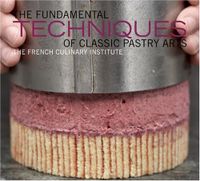Prue Leith's latest book is now on ckbk. Get 25% off ckbk Membership
The Basic Steps to the Proper Execution of Great Yeast-Leavened Bread Doughs
- Organize and weigh all your ingredients, taking care to select the finest available. This particularly applies to flour, butter, and eggs. Be certain that your yeast is active and that the required liquids are of the proper temperature.
- Mix the ingredients together following the exact order and method described in the recipe. If this is not done, the dough may not rise properly. You can mix by hand, use a wooden spoon, use a heavy-duty standing electric mixer fitted with the paddle attachment, use a heavy-duty food processor fitted with the metal blade, or follow manufacturer’s directions for an electric bread machine.
Knead in the style and for the length of time required in the recipe. This may be accomplished using a heavy-duty standing mixer fitted with the dough hook, a heavy-duty food processor fitted with the metal blade, an electric bread machine following manufacturer’s directions, or by hand. When kneading by hand, the dough is worked by pressing it down, then folding and turning it (usually by about a quarter turn) for anywhere from 5 to 20 minutes, until the dough is smooth and elastic. Whatever method of mixing and kneading is used, these processes serve to properly distribute the ingredients, develop the gluten in the flour through hydration, and set fermentation in motion.
The most reliable method for checking the proper development of gluten is known variously as the “windowpane test,” finding a “good window,” the membrane test, and “pulling a window.” A very small piece of dough is cut off from the main batch and is pulled, turned, and stretched to determine whether or not the dough can maintain an almost paper-thin, translucent sheet (or membrane). If it does not, then the dough should be mixed for another couple of minutes and tested again.
- Begin the first fermentation using the method and for the length of time called for in the specific recipe. A dough might receive its primary fermentation (or raising) covered, in an oiled bowl at room temperature (or warmer) for 1 to 2 hours. Or it might be immediately chilled to slow the fermentation process. Generally, the leaner the dough, the longer the fermentation required.
- Upon completion of the first fermentation, the dough must be punched down to expel the gases and relax the gluten. This is known as degassing. This may either be gently done with a simple transfer of the dough from the bowl to a work surface, or the dough may be manipulated for a period of time. The process you use to degas will determine the desired crumb of the baked product.
- The degassed dough is then neatly divided and scaled (weighed) into the exact proportions required by the recipe.
- The divided dough is shaped into the exact form required by the recipe such as loaf, ball, or round. This is not necessarily the final shape.
- The shaped dough may now be allowed to rest for a short period or it may immediately be formed into the final shape. If it is allowed to rest, the term used is “to bench” the dough, and the process will further relax the gluten.
- The final shaping of the dough is done in the style determined by the type of bread or pastry being made. There are an infinite number of prescribed shapes in classic baking techniques.
- The shaped dough is then given its second period of fermentation, which is known as proofing. (The primary fermentation is often called proofing too, but in the professional setting, the term usually applies only to the second fermentation.) During this final period of fermentation, the dough either rises to its final size and shape or to a near approximation of it. Proofing may take place in the pans in which the dough will be baked, in proofing baskets (known as bannetons or Brotform baskets), on or under a proofing cloth (known as a couche), or with the shaped dough placed on parchment or silicone-lined sheet pans. For any of these methods, the proofing will be completed for a specific amount of time in temperature- and moisture-controlled proofing boxes, in a refrigerated dough retarder (as in most professional pastry kitchens or bakeries), or for a period of up to 2 hours at a constant room temperature.
- The proofed dough is first marked or scored, if desired, and then baked in the style and for the length of time required. It is essential that the baker achieve the required degree of doneness necessary for the proper color and texture of the finished product.
- Once the bread is baked to perfection, it should be cooled in the exact method and for the period of time called for in the recipe.
Become a Premium Member to access this page
Unlimited, ad-free access to hundreds of the world’s best cookbooks
Over 150,000 recipes with thousands more added every month
Recommended by leading chefs and food writers
Powerful search filters to match your tastes
Create collections and add reviews or private notes to any recipe
Swipe to browse each cookbook from cover-to-cover
Manage your subscription via the My Membership page
Part of
Advertisement
Advertisement


